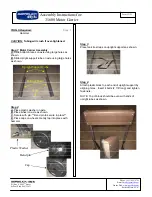
E
1-8
its course and speed. You must stay out
of its way until you are clear of it.
Likewise, if another vessel is passing you,
you should maintain your speed and
direction so that the other vessel can steer
itself around you.
OTHER SPECIAL SITUATIONS
There are three other rules you should be
aware of when driving your boat around
other vessels.
Narrow Channels and Bends
When navigating in narrow channels, you
should keep to the right when it is safe
and practical to do so. If the operator of a
power-driven vessel is preparing to go
around a bend that may obstruct the view
of other water vessels, the operator
should sound a prolonged blast on the
whistle (4 to 6 seconds). If another vessel
is around the bend, it too should sound
the whistle. Even if no reply is heard,
however, the vessel should still proceed
around the bend with caution. If you navi-
gate such waters with your boat, you will
need to carry a portable air horn, avail-
able from local marine supply stores.
Fishing Vessel Right-of-way
All vessels which are fishing with nets,
lines or trawls are considered to be“fish-
ing vessels” under the International
Rules. Vessels with trolling lines are not
considered fishing vessels. Fishing ves-
sels have the right-of-way regardless of
position. Fishing vessels cannot, howev-
er, impede the passage of other vessels in
narrow channels.
Sailing Vessel Right-of-way
Sailing vessels should normally be given
the right-of-way. The exceptions to this
are:
1.
When the sailing vessel is overtaking
the power-driven vessel, the power-
driven vessel has the right-of-way.
2.
Sailing vessels should keep clear of
any fishing vessel.
3.
In a narrow channel, a sailing vessel
should not hamper the safe passage
of a power-driven vessel which can
navigate only in such a channel.
Reading Buoys and Other Markers
The waters of the United states are
marked for safe navigation by the lateral
system of buoyage. Simply put, buoys
and markers have an arrangement of
shapes, colors, numbers and lights to
show which side of the buoy a boater
should pass on when navigating in a par-
ticular direction. The markings on these
buoys are oriented from the perspective
of being entered from seaward (the
boater is going towards the port). This
means that red buoys are passed on the
starboard (right) side when proceeding
from open water into port, and black
buoys are to port (left) side. When navi-
gating out of port, your position with
respect to the buoys should be reversed;
red buoys should be to port and black
buoys to starboard.
Many bodies of water used by boaters are
entirely within the boundaries of a partic-
ular state. The Uniform State Waterway
Marking System has been devised for
these waters. This system uses buoys and
signs with distinctive shapes and colors
to show regulatory or advisory informa-
tion. These markers are white with black
letters and orange boarders. They signify
speed zones, restricted areas, danger
areas, and general information.
6H3-9-1L 1 4/26/01 5:23 PM Page 13
Summary of Contents for 60A
Page 1: ...60A 70A 90A LIT 18626 04 56 60A 70A 90A OWNER S MANUAL U S A Edition ...
Page 2: ......
Page 4: ......
Page 6: ......
Page 22: ...E MEMO ...
Page 78: ...EMU00366 GREASING Yamaha marine grease Water resistant grease 4 17 103031 E ...
Page 101: ...1 2 3 4 5 E EMP00010 Chapter 6 INDEX INDEX 6 1 6 ...
Page 110: ......
Page 111: ......
Page 113: ...60A 70A 90A paper OWNER S MANUAL ...
















































